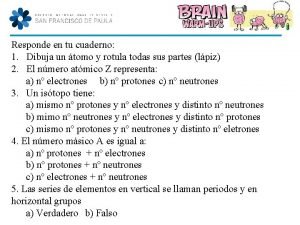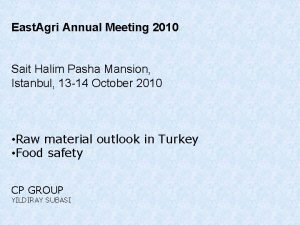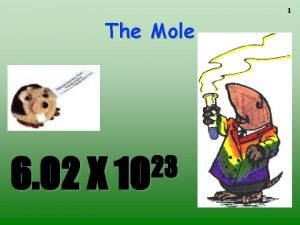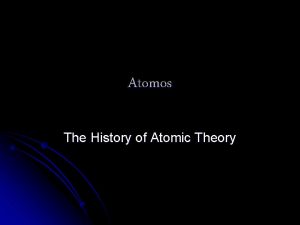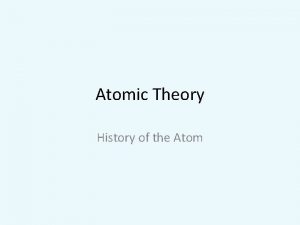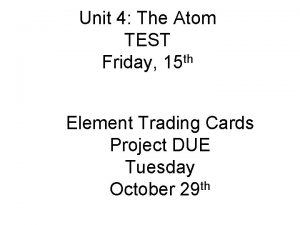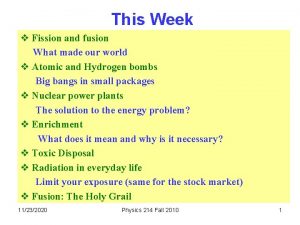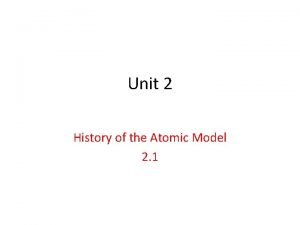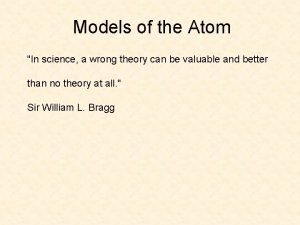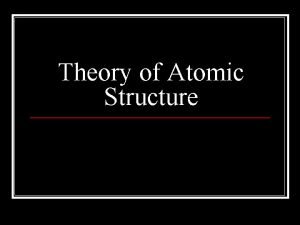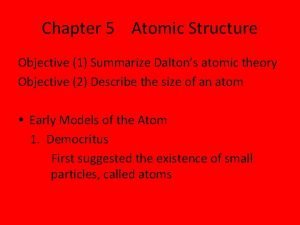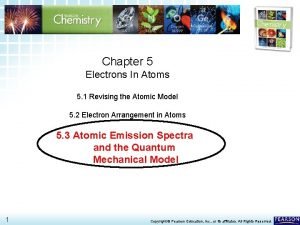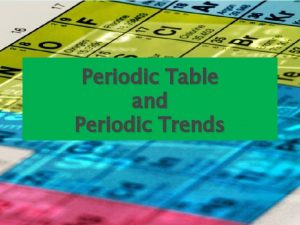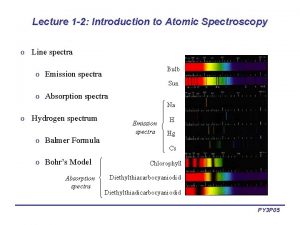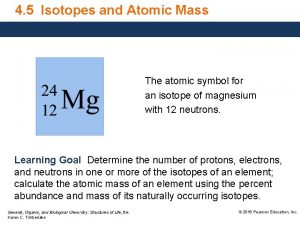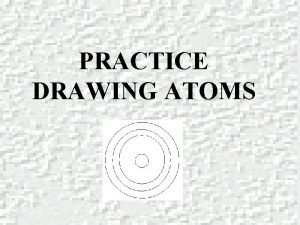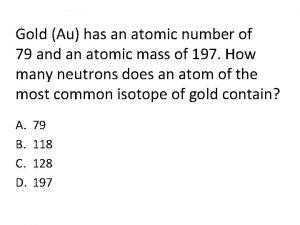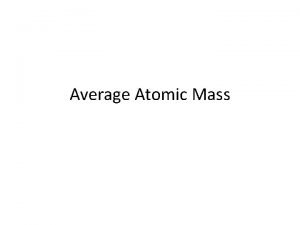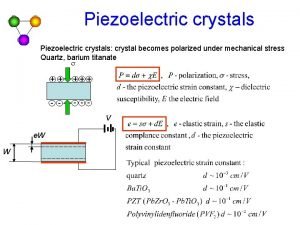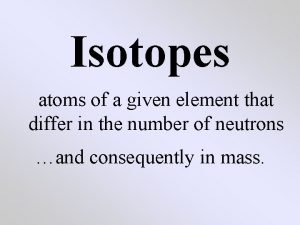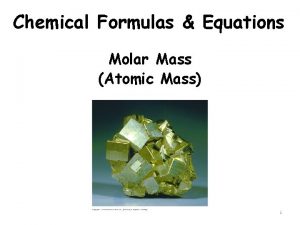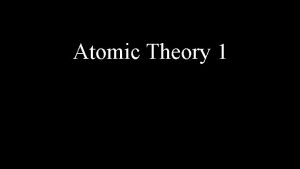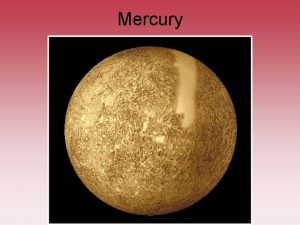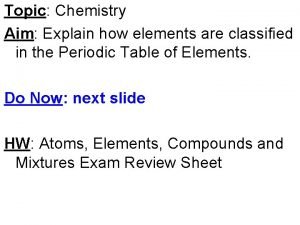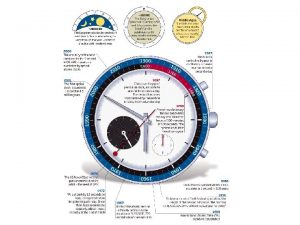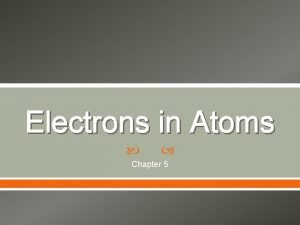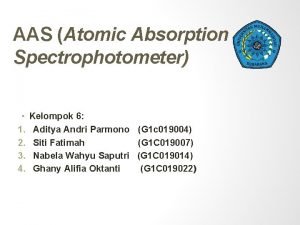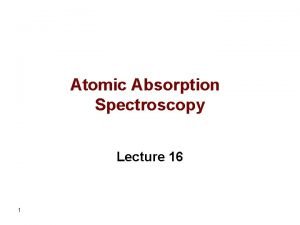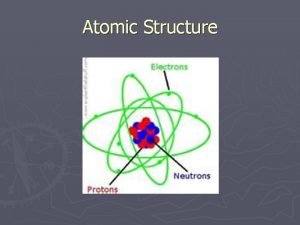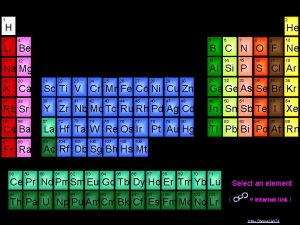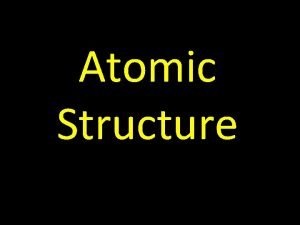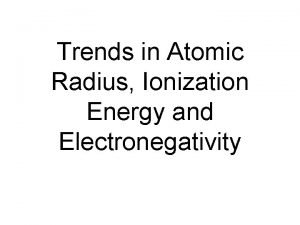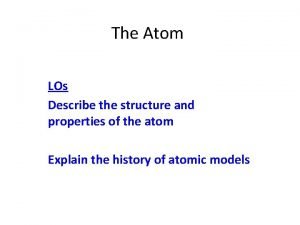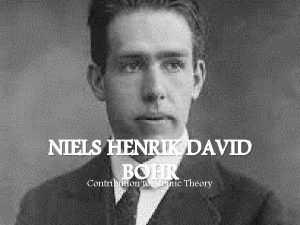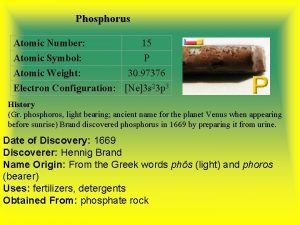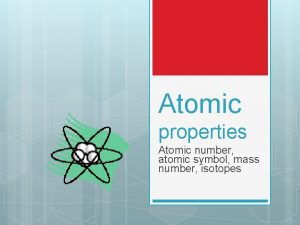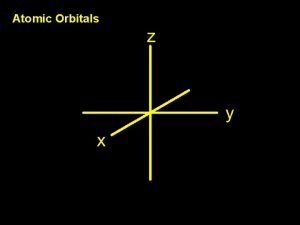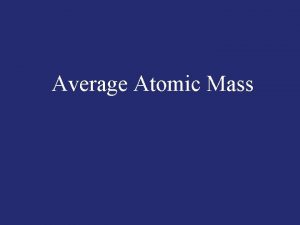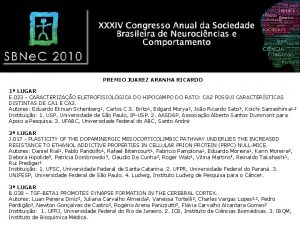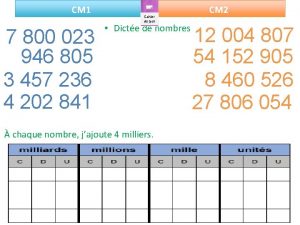Atomic wt 6 023 x 1023 wt 1








































































- Slides: 72





기본개념 원자량(Atomic wt) = 6. 023 x 1023 분자나 원자들의 wt 1 amu/atom = 1 g/mol 예) 철의 원자량= 55. 85 amu/atom=5. 85 g/mol, C 12. 011 H 1. 008 etc. 5




Atomic Structure • Valence electrons determine all of the following properties 1) 2) 3) 4) Chemical Electrical Thermal Optical 9


11



14

15



예제 • 파장 λ 가 121. 6 nm인 광자의 에너지를 J과 e. V로 구하라. (1. 0 e. V=1. 60 x 10 -19 J, h=6. 63 x 10 -34 J-s, 1 nm=10 -9 m) • 풀이: ΔE=hc/ λ이므로 ΔE=(6. 63 x 10 -34 J-s)(3. 0 x 108 m/s)/(121. 6 nmx 109 m/nm) =1. 63 x 10 -18 Jx 1 e. V/1. 60 x 10 -19 J=10. 2 e. V 18













31


33

34

35


37





42













Electronic Structure • Electrons have wavelike and particulate properties. – This means that electrons are in orbitals defined by a probability. – Each orbital at discrete energy level is determined by quantum numbers. Quantum # Designation n = principal (energy level-shell) l = subsidiary (orbitals) ml = magnetic K, L, M, N, O (1, 2, 3, etc. ) s, p, d, f (0, 1, 2, 3, …, n -1) 1, 3, 5, 7 (-l to +l) ms = spin ½, -½ 55

Electron Energy States Electrons. . . • have discrete energy states • tend to occupy lowest available energy state. 4 d 4 p N-shell n = 4 3 d 4 s Energy 3 p 3 s M-shell n = 3 Adapted from Fig. 2. 4, Callister & Rethwisch 3 e. 2 p 2 s L-shell n = 2 1 s K-shell n = 1 56

SURVEY OF ELEMENTS • Most elements: Electron configuration not stable. Element Atomic # Electron configuration Hydrogen 1 1 s 1 Helium 2 1 s 2 (stable) Lithium 3 1 s 2 2 s 1 Beryllium 4 1 s 2 2 s 2 Adapted from Table 2. 2, Boron 5 1 s 2 2 p 1 Callister & Rethwisch 3 e. Carbon 6 1 s 2 2 p 2. . . Neon 10 1 s 2 2 p 6 (stable) 1 s 2 2 p 6 3 s 1 Sodium 11 Magnesium 12 1 s 2 2 p 6 3 s 2 Aluminum 13 1 s 2 2 p 6 3 s 2 3 p 1. . . Argon 18 1 s 2 2 p 6 3 s 2 3 p 6 (stable). . Krypton 36 1 s 2 2 p 6 3 s 2 3 p 6 3 d 10 4 s 2 4 p 6 (stable) • Why? Valence (outer) shell usually not filled completely. 57

Electron Configurations • Valence electrons – those in unfilled shells • Filled shells more stable • Valence electrons are most available for bonding and tend to control the chemical properties – example: C (atomic number = 6) 1 s 2 2 s 2 2 p 2 valence electrons 58

Electronic Configurations ex: Fe - atomic # = 26 1 s 2 2 s 2 2 p 6 3 s 2 3 p 6 3 d 6 4 s 2 4 d 4 p N-shell n = 4 valence electrons 3 d 4 s Energy 3 p 3 s M-shell n = 3 Adapted from Fig. 2. 4, Callister & Rethwisch 3 e. 2 p 2 s L-shell n = 2 1 s K-shell n = 1 59

The Periodic Table give up 1 egive up 2 egive up 3 e- accept 2 eaccept 1 einert gases • Columns: Similar Valence Structure K Ca Sc Se Br Kr H He Li Be O F Ne Na Mg S Cl Ar Rb Sr Y Cs Ba Te I Adapted from Fig. 2. 6, Callister & Rethwisch 3 e. Xe Po At Rn Fr Ra Electropositive elements: Readily give up electrons to become + ions. Electronegative elements: Readily acquire electrons to become - ions. 60

Electronegativity • Ranges from 0. 7 to 4. 0, • Large values: tendency to acquire electrons. Smaller electronegativity Larger electronegativity Adapted from Fig. 2. 7, Callister & Rethwisch 3 e. (Fig. 2. 7 is adapted from Linus Pauling, The Nature of the Chemical Bond, 3 rd edition, Copyright 1939 and 1940, 3 rd edition. Copyright 1960 by Cornell University. 61

Ionic bond – metal + nonmetal donates accepts electrons Dissimilar electronegativities ex: Mg. O Mg 1 s 2 2 p 6 3 s 2 O 1 s 2 2 p 4 [Ne] 3 s 2 Mg 2+ 1 s 2 2 p 6 [Ne] O 2 - 1 s 2 2 p 6 [Ne] 62

Ionic Bonding • Occurs between + and - ions. • Requires electron transfer. • Large difference in electronegativity required. • Example: Na. Cl Na (metal) unstable Cl (nonmetal) unstable electron Na (cation) stable + Coulombic Attraction - Cl (anion) stable 63

Ionic Bonding • Energy – minimum energy most stable – Energy balance of attractive and repulsive terms EN = EA + ER = - A r - B rn Repulsive energy ER Interatomic separation r Net energy EN Adapted from Fig. 2. 8(b), Callister & Rethwisch 3 e. Attractive energy EA 64

Examples: Ionic Bonding • Predominant bonding in Ceramics Na. Cl Mg. O Ca. F 2 Cs. Cl Give up electrons Acquire electrons Adapted from Fig. 2. 7, Callister & Rethwisch 3 e. (Fig. 2. 7 is adapted from Linus Pauling, The Nature of the Chemical Bond, 3 rd edition, Copyright 1939 and 1940, 3 rd edition. Copyright 1960 by Cornell University. 65

Covalent Bonding • similar electronegativity share electrons • bonds determined by valence – s & p orbitals dominate bonding • Example: CH 4 C: has 4 valence e-, needs 4 more CH 4 H: has 1 valence e-, needs 1 more H Electronegativities are comparable. H C H shared electrons from carbon atom H shared electrons from hydrogen atoms Adapted from Fig. 2. 10, Callister & Rethwisch 3 e. 66

Primary Bonding • Metallic Bond -- delocalized as electron cloud • Ionic-Covalent Mixed Bonding % ionic character = x (100%) where XA & XB are Pauling electronegativities Ex: Mg. O XMg = 1. 3 XO = 3. 5 67

SECONDARY BONDING Arises from interaction between dipoles • Fluctuating dipoles asymmetric electron clouds + - secondary bonding + - ex: liquid H 2 H 2 H H secondary bonding Adapted from Fig. 2. 13, Callister & Rethwisch 3 e. • Permanent dipoles-molecule induced -general case: -ex: liquid HCl -ex: polymer + - H Cl secon dary b secondary bonding + secondary bonding H Cl ondin g - Adapted from Fig. 2. 14, Callister & Rethwisch 3 e. secondary bonding 68

Summary: Bonding Comments Type Bond Energy Ionic Large! Nondirectional (ceramics) Covalent Variable large-Diamond small-Bismuth Directional (semiconductors, ceramics polymer chains) Metallic Variable large-Tungsten small-Mercury Nondirectional (metals) Secondary smallest Directional inter-chain (polymer) inter-molecular 69

Properties From Bonding: Tm • Bond length, r • Melting Temperature, Tm Energy r • Bond energy, Eo ro Energy r smaller Tm unstretched length r o r Eo = “bond energy” larger Tm Tm is larger if Eo is larger. 70

Properties From Bonding : a • Coefficient of thermal expansion, a length, L o coeff. thermal expansion unheated, T 1 DL heated, T 2 DL = a (T 2 -T 1) Lo • a ~ symmetric at ro Energy unstretched length ro Eo Eo r smaller a a is larger if Eo is smaller. larger a 71

Summary: Primary Bonds Ceramics Large bond energy (Ionic & covalent bonding): Metals large Tm large E small a Variable bond energy (Metallic bonding): moderate Tm moderate E moderate a Polymers Directional Properties (Covalent & Secondary): Secondary bonding dominates small Tm small E large a secon dary b o nding 72
 6 023 x 1023
6 023 x 1023 Formula de los moles
Formula de los moles What is 80 023 written in scientific notation
What is 80 023 written in scientific notation Sait 023 024
Sait 023 024 American airlines flight 1023
American airlines flight 1023 Tmk1023
Tmk1023 Moles is equal to
Moles is equal to Jumlah mol dari 3,01 * 10 ^ 22 atom besi adalah
Jumlah mol dari 3,01 * 10 ^ 22 atom besi adalah 6 02 x 1023
6 02 x 1023 6 02 x 1023
6 02 x 1023 Ion size trend
Ion size trend Atomic number vs atomic radius
Atomic number vs atomic radius Periodic trends
Periodic trends Abundance calculation chemistry
Abundance calculation chemistry Relative formula mass of hcl
Relative formula mass of hcl Difference between atomic mass and atomic number
Difference between atomic mass and atomic number Atomos atomic model
Atomos atomic model History of atomic models
History of atomic models The atoms family atomic math challenge answer key
The atoms family atomic math challenge answer key Difference between atomic bomb and hydrogen bomb
Difference between atomic bomb and hydrogen bomb Moles to atoms formula
Moles to atoms formula Couchbase javascript
Couchbase javascript Meoms
Meoms Number of protons in hydrogen
Number of protons in hydrogen Hans geiger atomic theory
Hans geiger atomic theory Semiconductor atomic structure
Semiconductor atomic structure Atomic data center
Atomic data center Erwin schrödinger model of atom
Erwin schrödinger model of atom When did leucippus discover the atomic theory
When did leucippus discover the atomic theory Summarize dalton's atomic theory
Summarize dalton's atomic theory Atomos atomic model
Atomos atomic model Atomic emission spectra and the quantum mechanical model
Atomic emission spectra and the quantum mechanical model Atomic size increases down the group
Atomic size increases down the group Introduction to atomic spectra
Introduction to atomic spectra Average atomic mass of chlorine
Average atomic mass of chlorine Find the number of protons h
Find the number of protons h Carbon atom drawing
Carbon atom drawing Atomic model (1808)
Atomic model (1808) Oxygen periodic trends
Oxygen periodic trends Atomic number au
Atomic number au Atomic mass of chlorine
Atomic mass of chlorine Piezoelectric crystal atomic structure
Piezoelectric crystal atomic structure Atomic absorption spectroscopy history
Atomic absorption spectroscopy history Atomic size increases down the group
Atomic size increases down the group The isotope atoms differ in *
The isotope atoms differ in * Molar mass periodic table
Molar mass periodic table Jj thomson atomic theory
Jj thomson atomic theory Atomic theory vocabulary
Atomic theory vocabulary How to write atomic number and mass number
How to write atomic number and mass number Atomic number 15
Atomic number 15 What is mercurys atomic mass
What is mercurys atomic mass Nonbonding atomic solid examples
Nonbonding atomic solid examples Chromium orbital configuration
Chromium orbital configuration Where are the noble gases on the periodic table
Where are the noble gases on the periodic table Effective nuclear charge explained
Effective nuclear charge explained Atomic size pattern
Atomic size pattern Cesium fountain atomic clock
Cesium fountain atomic clock Atomic theory timeline
Atomic theory timeline Komponen aas
Komponen aas Discovery of atomic structure
Discovery of atomic structure Types of interference in atomic absorption spectroscopy
Types of interference in atomic absorption spectroscopy 460 democritus atom model
460 democritus atom model Democtritus
Democtritus Atomic nuclei
Atomic nuclei Average atomic mass formula
Average atomic mass formula Al atomic mass
Al atomic mass Z atomic symbol
Z atomic symbol Electronegativity trends
Electronegativity trends 13 al 27
13 al 27 Chapter 4 atomic structure vocabulary
Chapter 4 atomic structure vocabulary Niels bohr conclusion
Niels bohr conclusion A physical change occurs when a peach spoils
A physical change occurs when a peach spoils Atomic mass of copper in amu
Atomic mass of copper in amu

